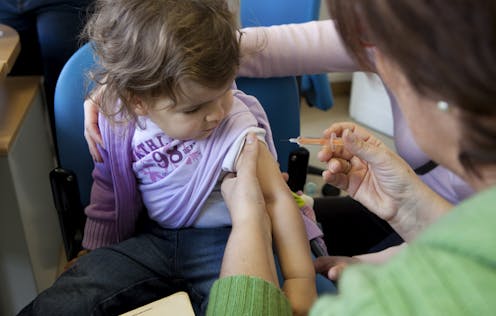Your child's vaccines: What you need to know about catching up during the COVID-19 pandemic
- Written by Irène Mathieu, Pediatrician, Assistant Professor of Pediatrics, University of Virginia

This spring, after stay-at-home orders were announced and schools shut down across the nation, many families stopped going to their pediatrician. As a result, kids have fallen behind on important childhood vaccinations.
Vaccination rates declined starkly[1] after mid-March, with up to 60% reductions in some areas of the country. Nationwide, vaccination rates dropped by 22%[2] among Medicaid and Children’s Health Insurance Program recipients under 2.
Now that kids are coming back to pediatricians like me[3], many parents have questions about catching up.
Why is it a problem that my child is behind on vaccines?
Vaccines protect your child from serious communicable diseases including brain infections, pneumonia, bloodstream infections and, in the case of the HPV and hepatitis B vaccines, even some types of cancer. The vaccine schedule we use was created to maximize your child’s protection throughout life.
In addition to protecting your child, vaccines protect others by decreasing the circulation of dangerous germs in our communities – we call this “herd immunity[4].”
Herd immunity is especially important to protect people who can’t get certain vaccines for medical reasons. When enough people are vaccinated, a disease can disappear altogether. For example, close to 95% of people need to be vaccinated against measles[5] to stop transmission of that virus. When the number of people who are adequately vaccinated drops too low, the whole community is at risk of an outbreak.
With the COVID-19 pandemic continuing across the country, the last thing we need is an outbreak of another deadly disease.
How do I figure out what my child needs to catch up?
This depends on your child’s age and which vaccines they’ve already received. The best way to figure out what your child needs is to call your pediatrician’s office and ask. There is a clear “catch-up schedule[6]” that we use to figure out which vaccines a child needs and when they can be given.
Many parents worry that getting too many shots at once could be dangerous. However, the amount of material contained in each vaccine is very, very small compared with all the different germs and substances our kids breathe in, eat and drink every day, not to mention what they’re exposed to when they scrape a knee or elbow.
There really is no such thing[7] as too many shots at once under current guidelines, although some shots can’t be given together on the same day.
What if my child is not feeling well when the pediatrician wants to give the vaccines?
For most kids, it is perfectly safe[8] to get vaccines when they have a mild illness – including a fever. Also, vaccines are no less effective if given when your child is sick.
It’s understandable that getting a lot of shots at once when your child isn’t feeling well can be upsetting for the child. You can talk to your pediatrician about which shots are most critical and ask that your child get those first and the rest on another day. At the same time, we still want people to stay home as much as possible to keep people safe from COVID, so try to get all of your child’s care done in as few visits as possible.
Does my child really need the flu shot?
The effectiveness of the flu shot varies each year. It is not 100% effective, but we still recommend it because this vaccine lowers your child’s risk of dying of the flu if he or she were to get sick.
Unfortunately, 188 children died of the flu[9] last year in the U.S. Many of these children were perfectly healthy before they got sick. Most of those who died had not received the flu shot.
Other parents worry that the flu shot itself will make their child sick.
[Deep knowledge, daily. Sign up for The Conversation’s newsletter[10].]
The injected influenza vaccine is made from dead flu virus, so it is not possible to get the flu from the vaccine. However, the shot may cause[11] a low-grade fever, fatigue or muscle soreness and swelling where the shot was given. These are signs that the body’s immune system is responding to the vaccine, which is exactly what we want! It’s the body’s way of training itself to recognize the flu virus, so when children come into contact with the virus later, their bodies knows how to fight it.
Should my child get the COVID-19 vaccine when one is available?
It is too soon to make recommendations about who should get a COVID-19 vaccine. It is highly unlikely that a safe and effective vaccine against COVID-19 will be widely available before 2021.
Because COVID is still circulating in our communities, it’s that much more important that we all work to ensure children are as protected as possible from other deadly diseases.
References
- ^ declined starkly (www.scientificamerican.com)
- ^ by 22% (www.cms.gov)
- ^ pediatricians like me (uvahealth.com)
- ^ herd immunity (theconversation.com)
- ^ vaccinated against measles (www.globalhealthnow.org)
- ^ catch-up schedule (www.cdc.gov)
- ^ no such thing (media.chop.edu)
- ^ perfectly safe (www.cdc.gov)
- ^ 188 children died of the flu (www.cdc.gov)
- ^ Sign up for The Conversation’s newsletter (theconversation.com)
- ^ may cause (www.cdc.gov)
Authors: Irène Mathieu, Pediatrician, Assistant Professor of Pediatrics, University of Virginia

